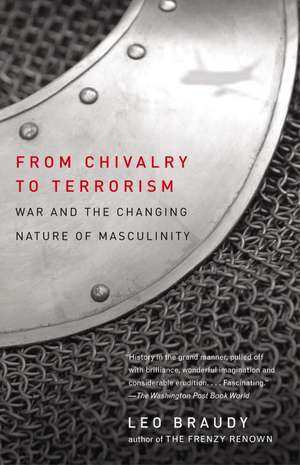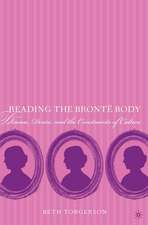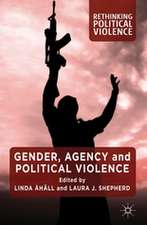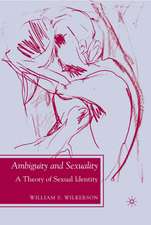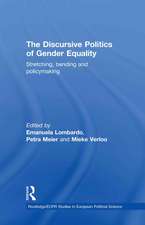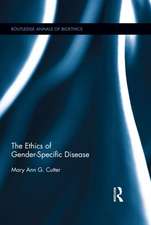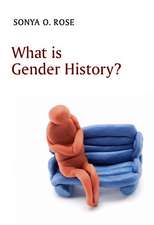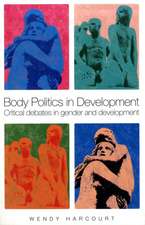From Chivalry to Terrorism: War and the Changing Nature of Masculinity
Autor Leo Braudyen Limba Engleză Paperback – 28 feb 2005
As he chronicles these transformations, Leo Braudy weighs the significance of everything from weapon technology to the hairstyles favored during different eras. He offers fresh insights on codes of war and codes of racial purity, and on cultural and historical figures from Socrates to Don Quixote to Napoleon to Custer to Rambo. Epic in scope and free of academic jargon, From Chivalry to Terrorism is a masterwork of scholarship that is both accessible and breathtakingly ambitious.
Preț: 173.73 lei
Nou
Puncte Express: 261
Preț estimativ în valută:
33.25€ • 34.35$ • 27.67£
33.25€ • 34.35$ • 27.67£
Carte disponibilă
Livrare economică 04-18 martie
Preluare comenzi: 021 569.72.76
Specificații
ISBN-13: 9780679768302
ISBN-10: 0679768300
Pagini: 613
Ilustrații: 40 ILLUSTRATIONS
Dimensiuni: 133 x 206 x 33 mm
Greutate: 0.59 kg
Editura: Vintage Books USA
ISBN-10: 0679768300
Pagini: 613
Ilustrații: 40 ILLUSTRATIONS
Dimensiuni: 133 x 206 x 33 mm
Greutate: 0.59 kg
Editura: Vintage Books USA
Notă biografică
Leo Braudy is University Professor and Bing Professor of English at the University of Southern California. He previously taught at Yale, Columbia, and Johns Hopkins. He has received a Guggenheim Fellowship as well as a Senior Scholar Fellowship from the National Endowment for the Humanities. He has been a fellow of the Rockefeller Foundation at the Villa Serbelloni in Bellagio, Italy, as well as a writer-in-residence at the American Academy in Rome. His book, Jean Renoir: The World of His Films, was a finalist for the National Book Award. Another of his books, The Frenzy of Renown: Fame and Its History, was a finalist for the National Book Critics Circle Award. He has written for the New York Times, the Washington Post, and Harper's. Mr. Braudy lives with his wife in Los Angeles.
Extras
1
REMEMBER MY NAME
Like the elephant sought by the six blind men, or the electron that changes position depending on when it is observed, masculinity must be mapped rather than merely discovered. Not only is it elusive, but there are also those with vested interests in keeping it mono-lithic and mysterious. Is masculinity, for example, entirely identifiable with patriarchy? That is, does masculinity in any age refer primarily to the power over groups considered to be weaker and more marginal to society-groups usually composed of women but also of men considered to be at best incomplete or imperfect, and at worst barely human? Certainly there have been many men, both in and out of public power, who believed and still believe this. But how was their own masculinity learned? Did it come directly from the experience of having the particular kind of male body their culture approved? Or are there a whole variety of preliminary and partial models, each with its own divergence from the grand norm and each with its contradiction of it?
One clue might be in the language of masculinity. Where do the words designating the male come from? What do they mean? In the West at least, this language has been heavily influenced by both the language of wartime masculinity (or fashioned in contrast to the language used to describe, say, the saint or the sage) and the language of social class. Man existed long before "masculine," a word that first appears in English in the Middle Ages as a French import used to designate not specific masculine characteristics so much as the general difference between male and female, whether in plants, animals, or human beings. Then, with the Norman conquest and the adoption of Norman-French as the standard for all educated discourse, "masculine" became a more frequent usage.*
"Man," as the older term, has a more tangled history. It goes back to an Indo-European root meaning "earth" that descends equally into "human" and "humus." There are two Latin words for man: vir and homo. Homo, related to the Greek word for "one" or "single," is the more general term-man in the abstract. It descends into the Romance languages fairly directly: uomo (Italian), homme (French), hombre (Spanish), and the impersonal pronoun in French, on. Vir in contrast refers to a man as defined by specific male qualities, and is the root of "virile" as well as "virtue," an association that prompted Plutarch in his biography of Coriolanus to complain that the Romans so valued military prowess that they made it stand for all human virtues, even though it refers to only one of them. Arma virumque cano, says Virgil at the beginning of the Aeneid, his epic poem of the founding of Rome: "I sing of arms and the man."
Unlike "masculine" and "feminine," which come from Latin, the immediate origin of "man" in English is Germanic. Like "masculine," "man" exists not as a concept in itself but amid an array of other possibilities: man as distinguished from boy, man as distinguished from woman, man as distinguished from beast, man as distinguished from demon, man as distinguished from gods and God. And perhaps the English embrace of the German man owes something to its similarity to the Latin manus, commonly "hand" but also a Roman legal term for the authority that a husband has over his wife.†
Much of human ritual and social organization, from the earliest tribes to contemporary societies, is preoccupied with reaffirming these distinctions-perhaps suggesting a deep-rooted human (or masculine) fear that they are arbitrary enough to be constantly in danger of erosion or forfeit. Like all distinctions, they are especially clouded in times like war, when events have pushed people, families, tribes, kingdoms, and nations to the edge. In this sense, much social ritual-initiation, marriage, preparation for war-is exorcism: the casting out of what is feared and the affirmation of what is desired. At these moments, the normal fuzziness and uncertainty of boundaries, the lack of sharp differences between aspects of human nature, have to be policed and polarized for fear that otherwise they will collapse entirely.
* "Masculine" comes from the Latin masculinus, which is itself a diminutive form of the adjective mas, meaning "male."
† To this list might be added man as distinguished from eunuch, to account for the Romanian word for man, barbat (bearded).
Contrary to the argument that patriarchal society consistently values the masculine in any polarized distinction, "man" is not always the superior term in all groups. Latin writers often used homo to refer to a man who is somehow not free, whether socially subordinate or otherwise dependent-a meaning retained in the modern use of "homage," which originally referred to the feudal ceremony of allegiance of a vassal to his lord. Similarly, one of the earliest uses of man in Old English was to designate a subordinate, a vassal, even a servant, as in the phrase "my man," and the early frequency of a phrase like "free man" implies that perhaps men in general were not free. It took some time before all men were said to be created equal, and it is not until the eighteenth century that "man" was used to refer to some abstract idea of human nature in general. Until then, the positive connotations of "man" referred almost exclusively to the behavior (often military) of a man of rank, an aristocrat, as in the suggestive relation in German between heer (army) and the honorific herr (lord, master).
It may seem to be an occasion for obvious Freudian mockery that a frequent Anglo-Saxon word for male human beings as well as animals is wæpned (weaponed). But even though wæpen could also mean "penis," we should remember that only a particular class of men had the wealth and the social sanction to carry weapons, and so the interplay between the words for "man," the words for "man of high rank," and the words for "warrior" has a long history. Thus in the eighth-century heroic poem Beowulf, written in Anglo-Saxon but telling the story of a sixth-century hero of the Danes, man appears in such compounds as feond mancynnes (enemy of mankind), while what translators usually call "manly behavior" or "heroic prowess" is referred to as eorlic ellen (the power of an earl, or noble) while "manly deeds" are eorlscipe efnde (the doings of earlship). Similarly, in The Song of Roland, an eleventh-century poem written about events of the eighth century, when a knight of Charlemagne's host fights with particular bravery, he is described as being en guise de baron, a phrase usually translated as "valiantly" or "heroically," but which literally means "in the manner of a baron." Some centuries before, baron had been the French word that generally distinguished the male from the female. By the eleventh century, in a process similar to that undergone by the words for "knight," baron appears as an actual social title for those high-ranking warriors who (as in The Song of Roland) support a higher-ranking lord or king. The title, of course, still remains in English, long since divested of its exclusively warlike implications. In Spanish it has gone back down the social scale to survive as varón-a man in general.*
Apart from the words themselves, much of the talk about what is "true" masculinity has also historically been tinged with, even steeped in, nostalgia for a lost masculinity. Gilgamesh begins by describing buildings of the past, "which no latter-day king, no man alive can equal." Even within the story of the Iliad itself, Nestor, the oldest of the Achaeans, frequently refers to the much greater warriors who walked the earth when he was younger, and he tries to instruct his not-so-heroic present-day comrades (heroic enough to Homer's audience and to us) in the fundamentals of battle tactics. With a similar longing after past greatness, Chaucer's Knight in The Canterbury Tales, who has come so quickly to the pilgrimage from war that his clothes are still smeared with the rust of his chain mail, tells a tale set in ancient Athens, when truly heroic knights fought for honor and the love of women.
One important component of masculinity thus embodies a myth of historical connection with past models and exemplars, while another looks to a future that will be different. As the Greek hero had to die young in the midst of battle in order to be considered a hero in song and legend, so one powerful form of masculinity is perpetually nostalgic in its judgments and standards. All the good men are already dead. That's how we know they're good. They may be dead, but their names and the masculinity they embodied live on to inspire future generations, and to ensure that other young, unmarried boys, who are not yet part of the settled social order, will go to war in the effort to be real men.
To a certain extent this is not entirely propaganda. From the impoverished medieval knight going to war to win estates and possessions by capturing enemy nobles for ransom, to the immigrant and ghetto-raised young men whose time in the army enables them to get an education and status that could almost never have been achieved outside, the military and especially wartime situations-with their immediate rewards for battlefield heroics and cunning tactics-have facilitated class change. In both hierarchic and democratic societies, the melting pot of war, defined by its total difference from peacetime stasis, has offered an outlet for otherwise stifled ambition. Periods of war thus often give rise to eras of social movement and change, and war's crucible of possibility has often engendered different ways of being a man, on and off the battlefield, even while it seeks to confirm the values of the past.
* As baron goes up the scale of social and cultural value, another early word for "man," the Old Norse karl (Old English ceorl) goes down, to become "churl" by Shakespeare's time. Compare the change from "villein" (a peasant serf) to "villain."
As the prime way of being a man, military masculinity thereby can assume the double aspect of both future goal and lost ideal, both for critics who are nostalgic for the past and for those who reject it entirely. Already in the late third century b.c. the Roman playwright Plautus, drawing on Aristophanes, had defined the stock type of the miles gloriosus, the blowhard old soldier constantly living in a fantasy of his past exploits. Shakespeare in his Henry plays splits such a character in two-the hot-blooded chivalric knight Harry Hotspur and the rollicking old campaigner Sir John Falstaff, both styles of military masculinity that are finally superseded, for better or worse, by the hard-edged pragmatism of Prince Hal, the future Henry V.
Whether as criticism or idealization, the presence of prior types of military masculinity in art and literature also implies a sense of generational change, especially when the wars in question are civil wars that divide families. The prewar and the postwar define a chasm that lasts long after the generations who actually participated are dead and gone. In the second half of the seventeenth century, both the French and the English looked back over the divide of their civil wars at the earlier part of the century as if it were an entirely different world.
A psychoanalytic perspective might call this conflict of male generations oedipal, and thereby a "natural" part of the male character. But such oedipal periods in culture are often brought into being by the experience of war. During war, personal honor comes at the expense of the enemy, but in times of peace it is the previous generation that often must pay. In the third of Shakespeare's Henry VI plays, which deal with the civil and foreign wars of fifteenth-century England, he dramatizes the inhumanity of the conflict specifically through an image of the clash of generations. In the midst of battle, Henry VI sits despairingly on a molehill and observes first, as the stage directions say, "a Son who hath Killed his father" and then "a Father that hath killed his son." Both enter bearing the bodies of people they thought were their enemies and then discover to be their kin. With less straightforward symbolism, the heroic plays of both England and France in the later seventeenth century, in the wake of the Thirty Years' War and the English Civil Wars, often feature conflicts between energetic sons and repressive fathers over questions of honor and duty. Likewise, after World War II, American westerns are shot through with conflicts between fathers and sons (and occasionally fathers and daughters). Red River (made in 1946-47 but not released until 1948), directed by Howard Hawks, for example, explicitly presents the conflict between father John Wayne and his adopted son Montgomery Clift as mediated by Clift's Civil War experience. Both are good with their guns, but Wayne's more brutal pioneering traits must be softened by war and history into Clift's more vulnerable, sympathetic-and successful-ones. Just as Hotspur in Henry V embodies an apolitical aggressiveness that must be superseded by Henry's new version of the warrior king, so in Red River, Wayne's outmoded, domineering, but still nostalgically treasured masculinity finally has to reach some accommodation with the ways of the new generation embodied by Clift.
2
THE LANGUAGE OF THE BODY
(What do you see when you turn out the light?)
I can't tell you, but I know it's mine.
-John Lennon and Paul McCartney,
"I Get By with a Little Help from My Friends"
The prime reason many might think it unlikely that masculinity has changed over time is the seemingly irreducible fact of the male body. Until new weaponry and social change brought women into military ranks, war was generally fought by men, whose physical nature seemed especially suitable for its hardships. Male bodies are generally taller and more robust than female, with longer, thicker muscles, and larger lungs, heart, and limb-to-body ratios, as well as the inability to become pregnant and thereby sacrifice valuable fighting time. In a common metaphor of male-female difference, men are hard and women are soft: "matter too soft a lasting mark to bear," wrote Alexander Pope in "To a Lady," his poem on the characters of women. Pope himself was about four-foot-six and suffered for most of his life from numerous ailments, including tuberculosis of the spine. So the seemingly absolute distinction between male and female in his hands carries an ironic charge: being soft, women were changeable and malleable, but also complex, while the hard, distinct male remained inflexibly the same.
But in less self-aware contexts this robust male hardness and imperviousness to change is itself unchangingly symbolized by the upright sword, the obelisk, and the column-all too easily accepted as figures for the aggressive and ever-ready penis, the most immediately obvious physiological difference between male and female, the most basic "fact" of all. In the imagery of the absolute biological distinction between male and female, affirmed by the popular use of Freudian formulas, the ritual phallus, the phallic symbol, and the actual penis are one and the same.
REMEMBER MY NAME
Like the elephant sought by the six blind men, or the electron that changes position depending on when it is observed, masculinity must be mapped rather than merely discovered. Not only is it elusive, but there are also those with vested interests in keeping it mono-lithic and mysterious. Is masculinity, for example, entirely identifiable with patriarchy? That is, does masculinity in any age refer primarily to the power over groups considered to be weaker and more marginal to society-groups usually composed of women but also of men considered to be at best incomplete or imperfect, and at worst barely human? Certainly there have been many men, both in and out of public power, who believed and still believe this. But how was their own masculinity learned? Did it come directly from the experience of having the particular kind of male body their culture approved? Or are there a whole variety of preliminary and partial models, each with its own divergence from the grand norm and each with its contradiction of it?
One clue might be in the language of masculinity. Where do the words designating the male come from? What do they mean? In the West at least, this language has been heavily influenced by both the language of wartime masculinity (or fashioned in contrast to the language used to describe, say, the saint or the sage) and the language of social class. Man existed long before "masculine," a word that first appears in English in the Middle Ages as a French import used to designate not specific masculine characteristics so much as the general difference between male and female, whether in plants, animals, or human beings. Then, with the Norman conquest and the adoption of Norman-French as the standard for all educated discourse, "masculine" became a more frequent usage.*
"Man," as the older term, has a more tangled history. It goes back to an Indo-European root meaning "earth" that descends equally into "human" and "humus." There are two Latin words for man: vir and homo. Homo, related to the Greek word for "one" or "single," is the more general term-man in the abstract. It descends into the Romance languages fairly directly: uomo (Italian), homme (French), hombre (Spanish), and the impersonal pronoun in French, on. Vir in contrast refers to a man as defined by specific male qualities, and is the root of "virile" as well as "virtue," an association that prompted Plutarch in his biography of Coriolanus to complain that the Romans so valued military prowess that they made it stand for all human virtues, even though it refers to only one of them. Arma virumque cano, says Virgil at the beginning of the Aeneid, his epic poem of the founding of Rome: "I sing of arms and the man."
Unlike "masculine" and "feminine," which come from Latin, the immediate origin of "man" in English is Germanic. Like "masculine," "man" exists not as a concept in itself but amid an array of other possibilities: man as distinguished from boy, man as distinguished from woman, man as distinguished from beast, man as distinguished from demon, man as distinguished from gods and God. And perhaps the English embrace of the German man owes something to its similarity to the Latin manus, commonly "hand" but also a Roman legal term for the authority that a husband has over his wife.†
Much of human ritual and social organization, from the earliest tribes to contemporary societies, is preoccupied with reaffirming these distinctions-perhaps suggesting a deep-rooted human (or masculine) fear that they are arbitrary enough to be constantly in danger of erosion or forfeit. Like all distinctions, they are especially clouded in times like war, when events have pushed people, families, tribes, kingdoms, and nations to the edge. In this sense, much social ritual-initiation, marriage, preparation for war-is exorcism: the casting out of what is feared and the affirmation of what is desired. At these moments, the normal fuzziness and uncertainty of boundaries, the lack of sharp differences between aspects of human nature, have to be policed and polarized for fear that otherwise they will collapse entirely.
* "Masculine" comes from the Latin masculinus, which is itself a diminutive form of the adjective mas, meaning "male."
† To this list might be added man as distinguished from eunuch, to account for the Romanian word for man, barbat (bearded).
Contrary to the argument that patriarchal society consistently values the masculine in any polarized distinction, "man" is not always the superior term in all groups. Latin writers often used homo to refer to a man who is somehow not free, whether socially subordinate or otherwise dependent-a meaning retained in the modern use of "homage," which originally referred to the feudal ceremony of allegiance of a vassal to his lord. Similarly, one of the earliest uses of man in Old English was to designate a subordinate, a vassal, even a servant, as in the phrase "my man," and the early frequency of a phrase like "free man" implies that perhaps men in general were not free. It took some time before all men were said to be created equal, and it is not until the eighteenth century that "man" was used to refer to some abstract idea of human nature in general. Until then, the positive connotations of "man" referred almost exclusively to the behavior (often military) of a man of rank, an aristocrat, as in the suggestive relation in German between heer (army) and the honorific herr (lord, master).
It may seem to be an occasion for obvious Freudian mockery that a frequent Anglo-Saxon word for male human beings as well as animals is wæpned (weaponed). But even though wæpen could also mean "penis," we should remember that only a particular class of men had the wealth and the social sanction to carry weapons, and so the interplay between the words for "man," the words for "man of high rank," and the words for "warrior" has a long history. Thus in the eighth-century heroic poem Beowulf, written in Anglo-Saxon but telling the story of a sixth-century hero of the Danes, man appears in such compounds as feond mancynnes (enemy of mankind), while what translators usually call "manly behavior" or "heroic prowess" is referred to as eorlic ellen (the power of an earl, or noble) while "manly deeds" are eorlscipe efnde (the doings of earlship). Similarly, in The Song of Roland, an eleventh-century poem written about events of the eighth century, when a knight of Charlemagne's host fights with particular bravery, he is described as being en guise de baron, a phrase usually translated as "valiantly" or "heroically," but which literally means "in the manner of a baron." Some centuries before, baron had been the French word that generally distinguished the male from the female. By the eleventh century, in a process similar to that undergone by the words for "knight," baron appears as an actual social title for those high-ranking warriors who (as in The Song of Roland) support a higher-ranking lord or king. The title, of course, still remains in English, long since divested of its exclusively warlike implications. In Spanish it has gone back down the social scale to survive as varón-a man in general.*
Apart from the words themselves, much of the talk about what is "true" masculinity has also historically been tinged with, even steeped in, nostalgia for a lost masculinity. Gilgamesh begins by describing buildings of the past, "which no latter-day king, no man alive can equal." Even within the story of the Iliad itself, Nestor, the oldest of the Achaeans, frequently refers to the much greater warriors who walked the earth when he was younger, and he tries to instruct his not-so-heroic present-day comrades (heroic enough to Homer's audience and to us) in the fundamentals of battle tactics. With a similar longing after past greatness, Chaucer's Knight in The Canterbury Tales, who has come so quickly to the pilgrimage from war that his clothes are still smeared with the rust of his chain mail, tells a tale set in ancient Athens, when truly heroic knights fought for honor and the love of women.
One important component of masculinity thus embodies a myth of historical connection with past models and exemplars, while another looks to a future that will be different. As the Greek hero had to die young in the midst of battle in order to be considered a hero in song and legend, so one powerful form of masculinity is perpetually nostalgic in its judgments and standards. All the good men are already dead. That's how we know they're good. They may be dead, but their names and the masculinity they embodied live on to inspire future generations, and to ensure that other young, unmarried boys, who are not yet part of the settled social order, will go to war in the effort to be real men.
To a certain extent this is not entirely propaganda. From the impoverished medieval knight going to war to win estates and possessions by capturing enemy nobles for ransom, to the immigrant and ghetto-raised young men whose time in the army enables them to get an education and status that could almost never have been achieved outside, the military and especially wartime situations-with their immediate rewards for battlefield heroics and cunning tactics-have facilitated class change. In both hierarchic and democratic societies, the melting pot of war, defined by its total difference from peacetime stasis, has offered an outlet for otherwise stifled ambition. Periods of war thus often give rise to eras of social movement and change, and war's crucible of possibility has often engendered different ways of being a man, on and off the battlefield, even while it seeks to confirm the values of the past.
* As baron goes up the scale of social and cultural value, another early word for "man," the Old Norse karl (Old English ceorl) goes down, to become "churl" by Shakespeare's time. Compare the change from "villein" (a peasant serf) to "villain."
As the prime way of being a man, military masculinity thereby can assume the double aspect of both future goal and lost ideal, both for critics who are nostalgic for the past and for those who reject it entirely. Already in the late third century b.c. the Roman playwright Plautus, drawing on Aristophanes, had defined the stock type of the miles gloriosus, the blowhard old soldier constantly living in a fantasy of his past exploits. Shakespeare in his Henry plays splits such a character in two-the hot-blooded chivalric knight Harry Hotspur and the rollicking old campaigner Sir John Falstaff, both styles of military masculinity that are finally superseded, for better or worse, by the hard-edged pragmatism of Prince Hal, the future Henry V.
Whether as criticism or idealization, the presence of prior types of military masculinity in art and literature also implies a sense of generational change, especially when the wars in question are civil wars that divide families. The prewar and the postwar define a chasm that lasts long after the generations who actually participated are dead and gone. In the second half of the seventeenth century, both the French and the English looked back over the divide of their civil wars at the earlier part of the century as if it were an entirely different world.
A psychoanalytic perspective might call this conflict of male generations oedipal, and thereby a "natural" part of the male character. But such oedipal periods in culture are often brought into being by the experience of war. During war, personal honor comes at the expense of the enemy, but in times of peace it is the previous generation that often must pay. In the third of Shakespeare's Henry VI plays, which deal with the civil and foreign wars of fifteenth-century England, he dramatizes the inhumanity of the conflict specifically through an image of the clash of generations. In the midst of battle, Henry VI sits despairingly on a molehill and observes first, as the stage directions say, "a Son who hath Killed his father" and then "a Father that hath killed his son." Both enter bearing the bodies of people they thought were their enemies and then discover to be their kin. With less straightforward symbolism, the heroic plays of both England and France in the later seventeenth century, in the wake of the Thirty Years' War and the English Civil Wars, often feature conflicts between energetic sons and repressive fathers over questions of honor and duty. Likewise, after World War II, American westerns are shot through with conflicts between fathers and sons (and occasionally fathers and daughters). Red River (made in 1946-47 but not released until 1948), directed by Howard Hawks, for example, explicitly presents the conflict between father John Wayne and his adopted son Montgomery Clift as mediated by Clift's Civil War experience. Both are good with their guns, but Wayne's more brutal pioneering traits must be softened by war and history into Clift's more vulnerable, sympathetic-and successful-ones. Just as Hotspur in Henry V embodies an apolitical aggressiveness that must be superseded by Henry's new version of the warrior king, so in Red River, Wayne's outmoded, domineering, but still nostalgically treasured masculinity finally has to reach some accommodation with the ways of the new generation embodied by Clift.
2
THE LANGUAGE OF THE BODY
(What do you see when you turn out the light?)
I can't tell you, but I know it's mine.
-John Lennon and Paul McCartney,
"I Get By with a Little Help from My Friends"
The prime reason many might think it unlikely that masculinity has changed over time is the seemingly irreducible fact of the male body. Until new weaponry and social change brought women into military ranks, war was generally fought by men, whose physical nature seemed especially suitable for its hardships. Male bodies are generally taller and more robust than female, with longer, thicker muscles, and larger lungs, heart, and limb-to-body ratios, as well as the inability to become pregnant and thereby sacrifice valuable fighting time. In a common metaphor of male-female difference, men are hard and women are soft: "matter too soft a lasting mark to bear," wrote Alexander Pope in "To a Lady," his poem on the characters of women. Pope himself was about four-foot-six and suffered for most of his life from numerous ailments, including tuberculosis of the spine. So the seemingly absolute distinction between male and female in his hands carries an ironic charge: being soft, women were changeable and malleable, but also complex, while the hard, distinct male remained inflexibly the same.
But in less self-aware contexts this robust male hardness and imperviousness to change is itself unchangingly symbolized by the upright sword, the obelisk, and the column-all too easily accepted as figures for the aggressive and ever-ready penis, the most immediately obvious physiological difference between male and female, the most basic "fact" of all. In the imagery of the absolute biological distinction between male and female, affirmed by the popular use of Freudian formulas, the ritual phallus, the phallic symbol, and the actual penis are one and the same.
Recenzii
“History in the grand manner, pulled off with brilliance, wonderful imagination and considerable erudition. . . . Fascinating.” — The Washington Post Book World
“History at its most powerful. It is impossible to do justice to the range of fascinating material in this book.” –Los Angeles Times Book Review
“The reader is left marveling. . . . An expansive, ambitious project.” –San Francisco Chronicle
“A terrific topic . . . The book displays Braudy’s loving immersion in his subject, fine grasp of historical complexity, and aversion for glib or dogmatic judgments.” –The New York Times Book Review
“A vivid, hugely ambitious book . . . Likely to be widely read.” –The New York Review of Books
“History at its most powerful. It is impossible to do justice to the range of fascinating material in this book.” –Los Angeles Times Book Review
“The reader is left marveling. . . . An expansive, ambitious project.” –San Francisco Chronicle
“A terrific topic . . . The book displays Braudy’s loving immersion in his subject, fine grasp of historical complexity, and aversion for glib or dogmatic judgments.” –The New York Times Book Review
“A vivid, hugely ambitious book . . . Likely to be widely read.” –The New York Review of Books
